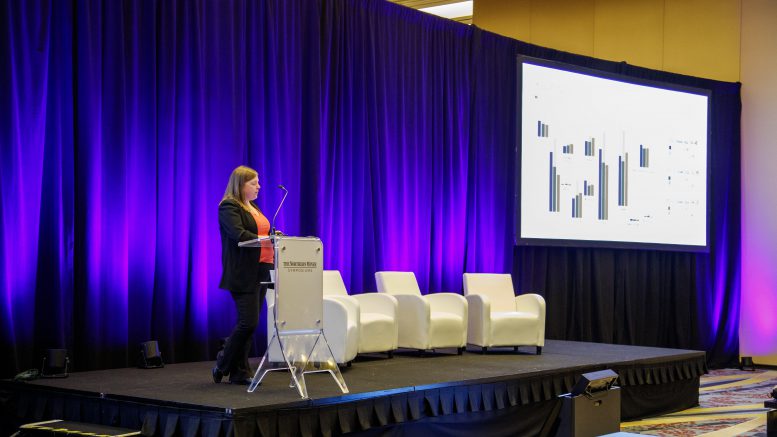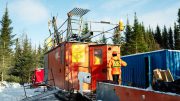Exploration spending in British Columbia is down by more than 45% since 2022, the biggest drop of any jurisdiction in Canada, PearTree Financial managing director Kendra Johnston said at the Energy Transition Metals Summit in Washington, D.C. in April.
“We see quite a large decrease over the three years in British Columbia,” said Johnston, a former president and CEO of the Association for Mineral Exploration (AME) in the province. Spending in B.C. dropped to $543.6 million this year from $764.6 million last year and $996.8 million in 2022, she said at the event, organized by The Northern Miner and Precious Metals Summit Conferences. “There are a number of regulatory changes that are happening… there is some uncertainty related to the Mineral Tenure Act and the Mines Act and some of the activities related to how well we’re going to be able to explore in that province.”
Watch the video with Kendra Johnston above.
The B.C. Supreme Court last September gave the province 18 months to align the mineral claims process under the Mineral Tenure Act (MTA) with the duty to consult Indigenous groups.
Just six months later, the AME criticized the province for not properly engaging with the mining industry in its work to reform the MTA. Some companies in B.C., such as Taranis Resources (TSXV: TRO; US-OTC: TNREF), have also been frustrated with the province by what it considers a politicized process towards permitting. The company finally secured an exploration permit for its Thor project in April after a court dispute and almost two years of waiting.
Johnston’s Canada’s Critical Mineral Landscape and Financial Trends presentation on April 29, sponsored by PearTree Canada, touched on the federal Critical Mineral Strategy, released in 2022 and how exploration by dollars, minerals and financing are playing out across the country.
By contrast with B.C., Ontario leads the country in spending with $1.1 billion, with Quebec’s $904.2 million coming in second, Johnston said, citing data from the federal government. That’s out of the cross-Canada total this year of $4.1 billion, which includes $2.7 billion in exploration and $1.4 billion in deposit appraisals, already more than the $3.9 billion spent last year.
Alberta and Saskatchewan are on track to clock their highest spending in three years, with lithium brine exploration pushing up investment in Alberta to $50.1 million this year, Johnston said, and uranium activity in Saskatchewan amounting to $442.8 million.
Flow-through flowing high
In terms of equity financing, Johnston pointed to data from the TMX Group and the Prospectors and Developers Association of Canada showing that flow-through shares financing, a uniquely Canadian type of financing that carries an attached tax benefit, has risen over the last decade. PearTree dominates flow-through financings in Canada.
Since 2021, the proportion of flow-through to non-flow-through financing for mineral exploration reached its highest levels in the last three years, at 83% in 2021, 78% in 2022 and 83% again last year.
“(And) of that 83%, 90% is charity flow through,” Johnston said, referring to the flow-through system where investors buy shares and then donate them to a Canadian charity. “That is a significant component of how projects are financed across the country. That works out to 74% of all financings are done by charity flow through.”
Because of the exploration sector’s dependence on flow-through dollars, changes to the alternative minimum tax introduced in federal budget 2024 may harm the sector disproportionately, PearTree has warned. The new tax regime will target high income Canadians who contribute to most flow-through financings. PearTree fears it could cut financing for mineral exploration by one-third.
Almost half of the total $1.2 billion in flow-through financing raised in 2021 was in Ontario, at $467 million; 29% or $353 million were bought in Quebec; and 20% or $243 million were bought in B.C. The remaining $140 million were bought in other jurisdictions.
Johnston explained that the person buying the flow-through shares needs to be in the same province or territory where the dollars are being spent, leaving jurisdictions with smaller populations at a disadvantage.
Critical minerals rising
In the wider picture of all mineral exploration in Canada, base and precious metals together dominate spending at more than $3 billion, though they’re down by more than $500 million compared to 2022. Spending on uranium and critical minerals, on the other hand, more than doubled to over $250 million last year from 2022.
“When we look at the 2023 compared to 2022 numbers, we saw a very small increase in exploration projects,” Johnston said. “But interestingly, a decrease in the number of companies that were exploring, and almost a 25% decrease in the amount of drilling that was going on.”
By individual critical minerals, copper was at the top in 2023 for the number of exploration projects, at just over 40, though that’s down by about 10 from 2022. Uranium saw the largest increase to almost 20 projects in 2023 from less than five the year before.
The nuclear metal also posted the highest increase in critical mineral exploration dollars last year, at $150 million, a more than 90% rise over 2022. Lithium led all spending in 2023, at almost $275 million, though it was down from almost $350 million in 2022.
Expanding Indigenous presence
Another trend Johnston pointed to is growing participation of First Nations in exploration projects.
She noted there are more than 500 agreements made with Indigenous groups across the country, ranging from letters of intent to more advanced impact benefit and revenue sharing agreements.
“When you look at how many projects there are, it’s more than half of the major projects that are out there,” Johnston said. “We have moved past the realm of consent and consensus and we’re moving now into a space of full participation, (including) equity participation… from jobs and training, right through to ownership.”
Citing three Indigenous-owned companies in the space, including the recently-formed Nations Royalty, she said they show Indigenous people are now taking leading roles in the industry.
“They have geologists, they have engineers, they have accountants and lawyers and CEOs and the whole gamut of individuals, and many of them are entirely First Nation employees.”






Be the first to comment on "JV Content: PearTree tracks financial trends that show declining exploration spending in BC"